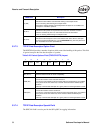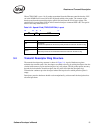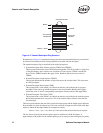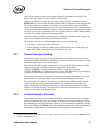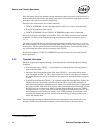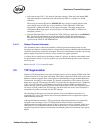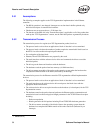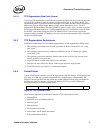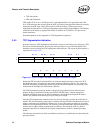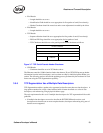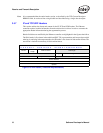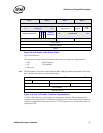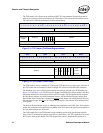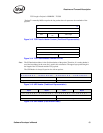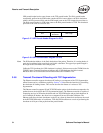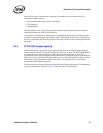
Receive and Transmit Description
58 Software Developer’s Manual
• TCP with options
• UDP with limitations.
UDP (unlike TCP) is not a “reliable protocol”, and fragmentation is not supported at the UDP
level. UDP messages that are larger than the MTU size of the given network medium are normally
fragmented at the IP layer. This is different from TCP, where large TCP messages can be
fragmented at either the IP or TCP layers depending on the software implementation. The Ethernet
controller has the ability to segment UDP traffic (in addition to TCP traffic). This process has
limited usefulness.
IP tunneled packets are not supported for TCP Segmentation operation
1
.
3.5.5 TCP Segmentation Indication
Software indicates a TCP Segmentation transmission context to the hardware by setting up a TCP/
IP Context Transmit Descriptor. The purpose of this descriptor is to provide information to the
hardware to be used during the TCP segmentation offload process. The layout of this descriptor is
reproduced in Section 3.3.6.
Figure 3-6. TCP/IP Context Transmit Descriptor & Command Layout
Setting the TSE bit in the Command field to 1b indicates that this descriptor refers to the TCP
Segmentation context (as opposed to the normal checksum offloading context). This causes the
checksum offloading, packet length, header length, and maximum segment size parameters to be
loaded from the descriptor into the Ethernet controller.
The TCP Segmentation prototype header is taken from the packet data itself. Software must
identity the type of packet that is being sent (IP/TCP, IP/UDP, other), calculate appropriate
checksum offloading values for the desired checksums, and calculate the length of the header
which is pre-pended. The header may be up to 240 bytes in length.
Once the TCP Segmentation context has been set, the next descriptor provides the initial data to
transfer. This first descriptor(s) must point to a packet of the type indicated. Furthermore, the data it
points to may need to be modified by software as it serves as the prototype header for all packets
within the TCP Segmentation context. The following sections describe the supported packet types
and the various updates which are performed by hardware. This should be used as a guide to
determine what must be modified in the original packet header to make it a suitable prototype
header.
The following summarizes the fields considered by the driver for modification in constructing the
prototype header:
63 48 47 40 39 32 31 16 15 8 7 0
0 TUCSE TUCS0 TUCSS IPCSE IPCS0 IPCSS
8 MSS HDRLEN RSV STA TUCMD DTYP PAYLEN
63 48 47 40 3936 35 32 31 24 23 20 19 0
7 6 5 4 3 2 1 0
IDE RSV DEXT RSV RS TSE IP TCP



